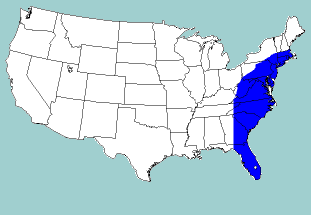

Descriptive Qualities:
Range
Tulip-Tree's range is
Map of this moth's Area:

Eggs and Larva
The female Tulip-tree moth carries,
depending on size of
particular moth, approximately 150 - 300 eggs. Tulip-tree larva are similar to Promethea in 1st instar, but are lighter in color. In 2nd instar they again look similar but still are lighter. In 3rd instar they are completely white with 4 tuberacles at their front and one on the back. In 4th instar, the 4 front tuberacles become red, with no change to anything else.
Scenting and Mating
Female Tulip-Trees usually put their scent out from dark until 2:00 AM. The males may come in at any time during this period. It is easiest to put the female in a metal cage with holes big enough that they can mate through it (about a half inch or 3/4 inch hole should do nicely) but small enough that the female cannot escape. This way is the only real way to tell how many came in.
Cocoons
Tulip-Tree larva make very strong cocoons that hang on the branch of the trees they are feeding on. They sometimes move further down the tree, close to the ground, to make their cocoon, but never make them on the ground. Tulip-Tree's have 1 brood the North, with a possible 2 broods in the South.
Personal Markings or Characteristics
Tulip-tree moths are sexually dimorphic. The male is a dark brown color, while the female is like brown to orange. The Tulip-tree moth looks similar to the Promethea but the crescents on the wings extend further back on their wings.
Caring For Tulip-Tree moths, In All Stages:
Here are some notes that may be helpful when trying to raise Tulip-Tree larva, especially if it's your first time raising them.Caring for the eggs
To care for Tulip-Tree eggs, just put them in a small container. It is best to be small, because the larva like to crawl a lot when they first hatch, and if you put them in a bigger container, they will crawl away from the food you put in with them, and might not be able to get back. That's a lot of area for such a small caterpillar.
Food Plants
Raising Tulip-Tree Larva (Inside)
Unknown, will post when available.
Raising Cecropia Larva (Outside)
Sleeving Tulip-tree larva works best. They are not tolerant of crowding, so no more than 10 should be put in each net.
Caring for the cocoons
Caring for the cocoons is pretty simple. You should put them in an area where it is fairly moist, if the cocoons dry out, they will die. If you just put them outside they should be fine. You cannot leave them inside, because they will hatch, but you can keep them in the refridgerator. If you do this, it is best to spray the cocoons with a light mist every once in a while so they don't dry out.
Click here to return to the Index
Comments and suggestions are welcome, send them to me at: [email protected]